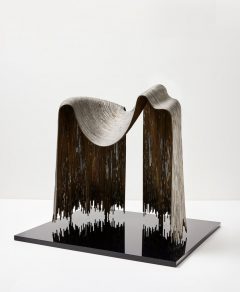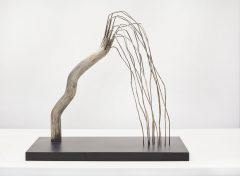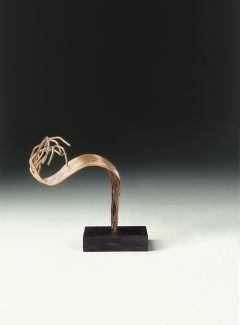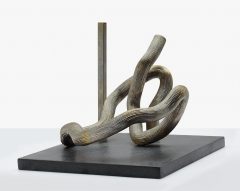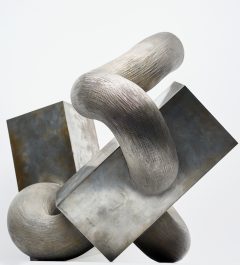
Brass and tin
66 × 81 × 62 cm l 26 × 32 × 24 1/2 in
Edition of Unique
Catalogue raisonné by Költzsch 1992 no. 250
The artist’s studio; Marlborough Galerie, Zurich
- Galerie Hennemann, "Matschinsky-Denninghoff", Bonn 1980
- Goethe-Institut, "Attraction 1924-1969. Sculptures – Peintures – Gravures", Paris 1969
- Georg W. Költzsch/Anette Schwarz, "Matschinsky-Denninghoff. Monographie und Werkverzeichnis der Skulpturen", Köln 1992, no. 250
- Manfred de la Motte (Hg.), "Matschinsky-Denninghoff", Ausst.-Kat. Galerie Hennemann, Bonn 1980, n. p.
- Goethe-Institut, "Attraction 1924-1969. Sculptures – Peintures – Gravures", Ausst.-Kat., Paris 1969, no. 34
Since the end of the 1950s, a newly found lightness in stylistic structure and expression has been evident in design, architecture and sculpture. Sculpture, in particular, is experiencing an innovation that can be traced back, among other things, to the Constructivism influenced by the brothers Naum Gabo and Antoine Pevsner. As early as 1920, Gabo and Pevsner formulated "Das Realistische Manifest" (The Realistic Manifesto), an important typeface for the generation of sculptors immediately following the Second World War, which was to redefine the self-image of sculpture in five points. Space and time were declared to be standards of art and called upon as opponents of the fetish of speed in Futurism. The materiality of the material should appear entirely in its original state without the use of colour and exist in its surroundings. No other element could function better for the clarification of static forces, movement and rhythm without volume in three-dimensional space than the line.1
An artistic orientation towards the "Realist Manifesto" and the new lightness of the 1950s cannot be dismissed in the sculptures of Martin and Brigitte Matschinsky-Denninghoff. The dynamically dissolved, plastic bodies are always subject to a technical and formal-aesthetic law or regularity that has been consolidated over the years. They form their own spaces in which they unfold and with which they seem to enter into an indissoluble symbiosis in the industrial originality of the materials - brass, tin, copper and in large sculptures for public spaces also chrome-nickel steel. Since 1955, the year of the artist's wedding, the metal sculptures, composed of lines, rods and tubes, have been opening up haunting views and moving views. Since the late 1960s, the sculptures no longer consist only of vertical and/or horizontal rods, which become dynamic plates or organic tubes, but also of diagonals as lines. In 1967, however, the formal language completely changed: the sculptural opening evoked by the lightness of the line into the room was now supplemented by compact cubic forms, so that a new, self-contained dramatic spatial experience could be experienced.2
In our 1968 work "Kala", the cubic forms consist of two identical parallelepipeds from which seemingly animated pipes emerge and simultaneously pierce them. The result is a charged dynamic that suggests movement and growth. The organic motion of the winding pipes is emphasized not only by the contrast of the voluminous bodies, but also by the typical Matschinsky-Dennighoff ascending structure of the sculpture from bottom to top. In Matschinsky-Dennighoff's sculptures, the viewer is thus constantly entangled in an exciting exchange with the aesthetically visible contradiction between open and closed, lightness and volume, abstraction and figurativeness.
1 Cf. Naum Gabo/Antoine Pevsner, "The Realist Manifesto", Moscow 1920, pp. 203-204.
2 Cf. Georg W. Költsch, "Matschinsky-Denninghoff. Monograph and Catalogue of Sculptures", Cologne 1992, p. 98.
